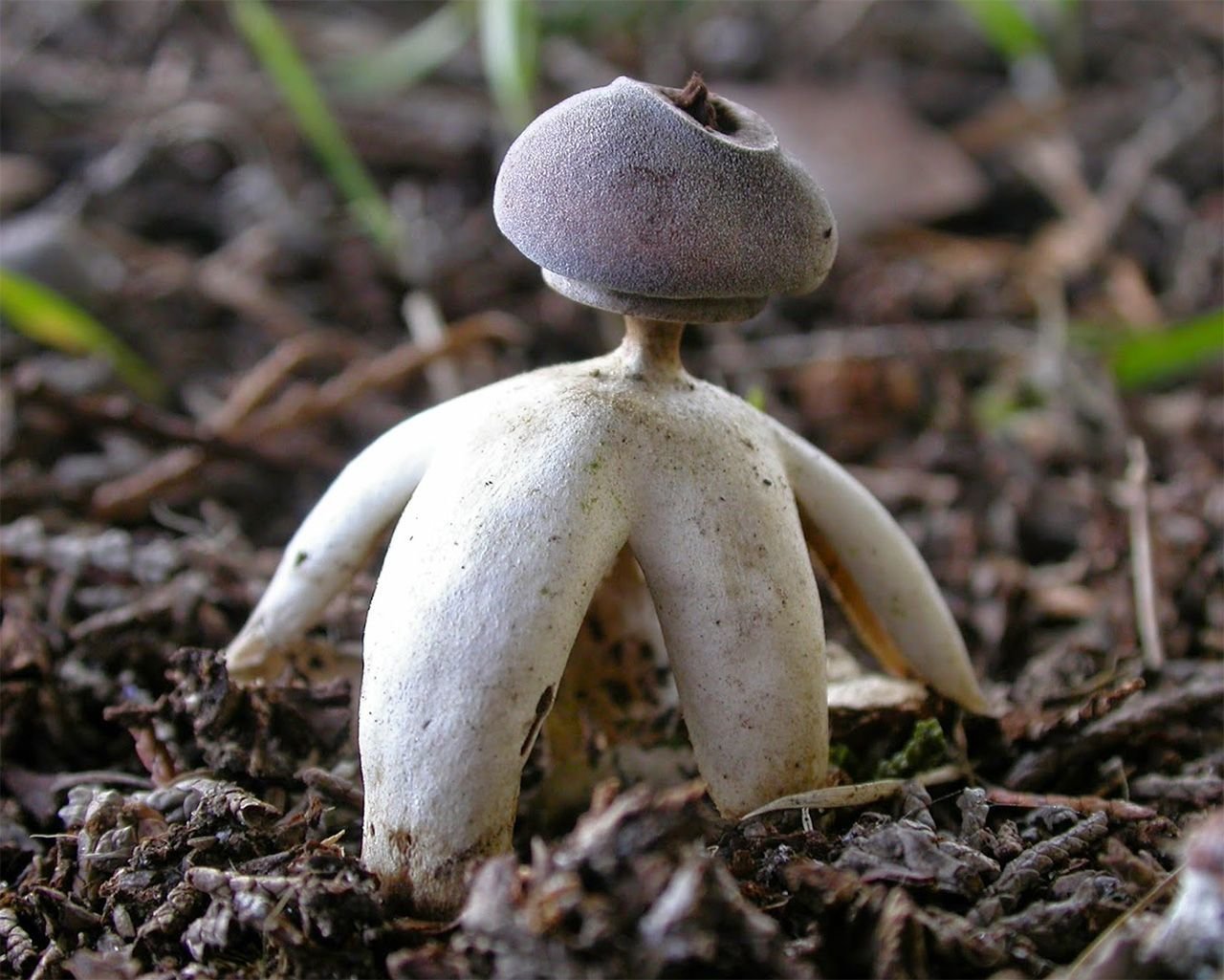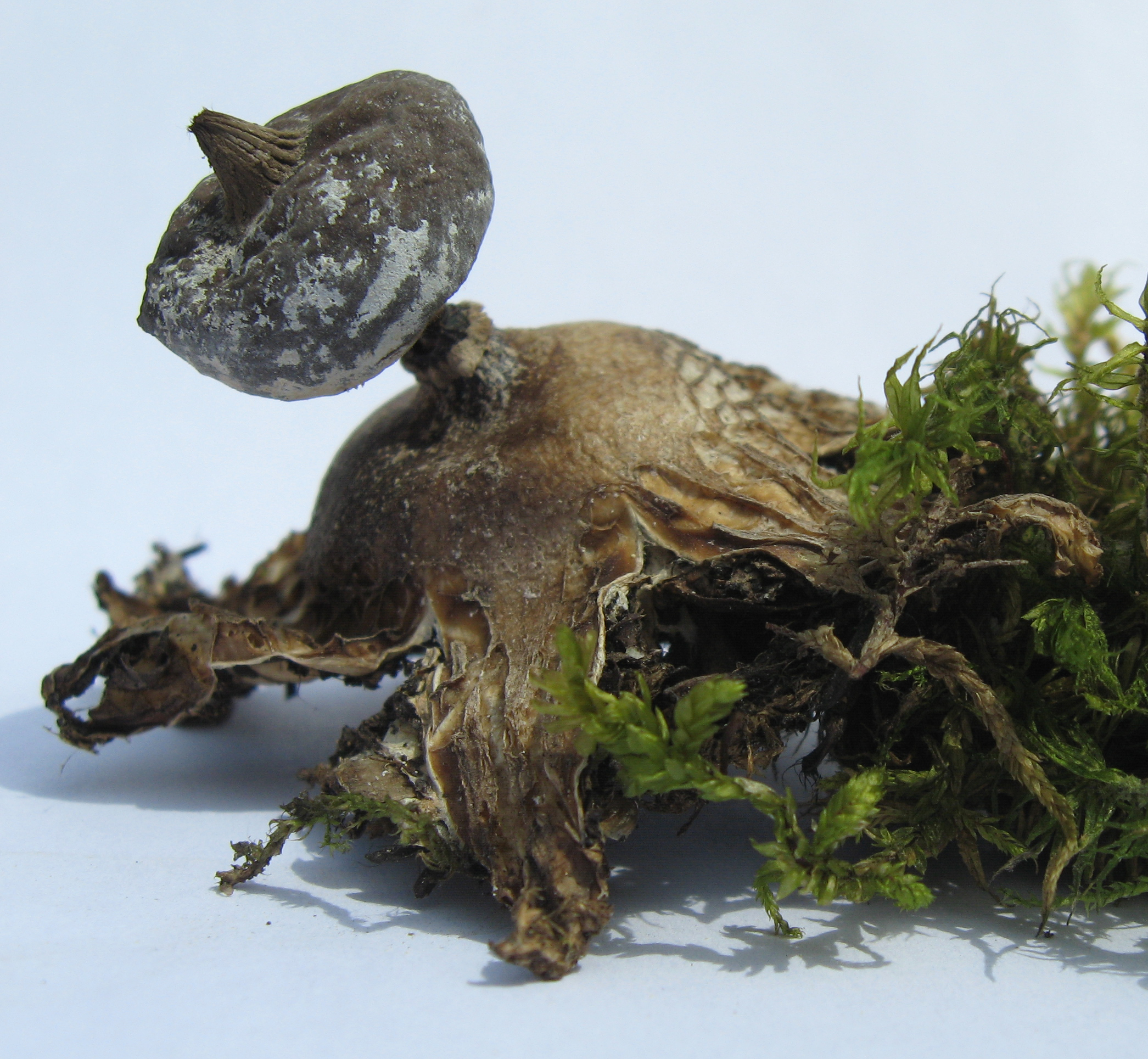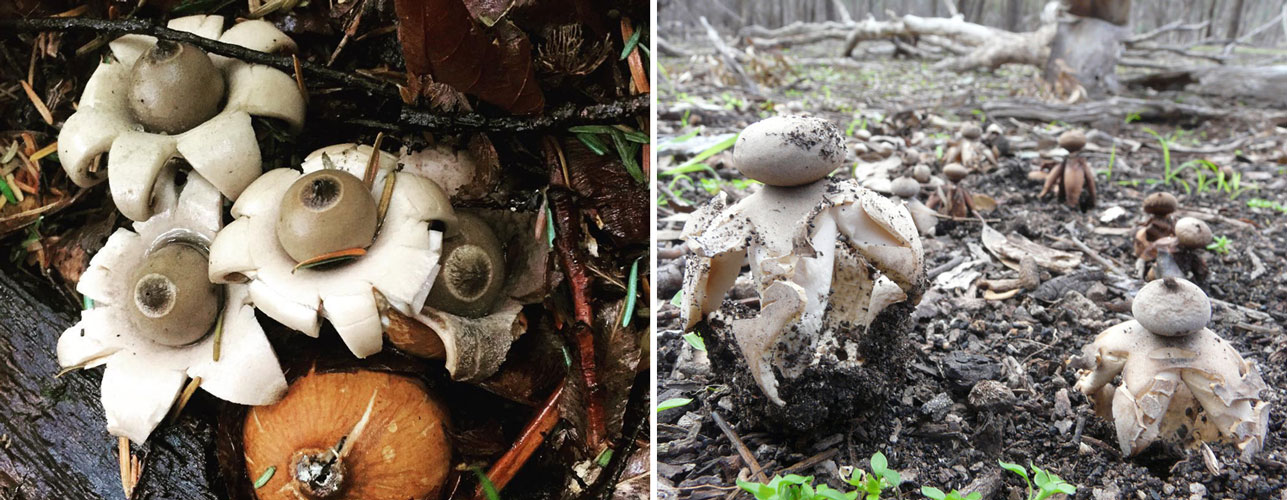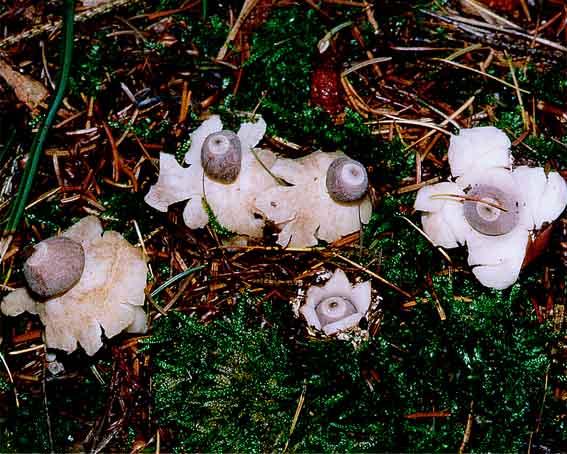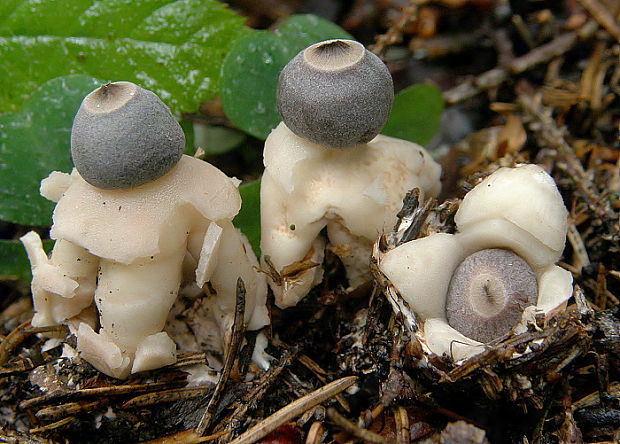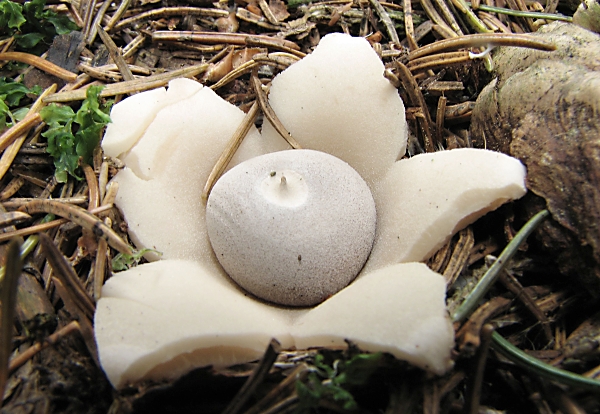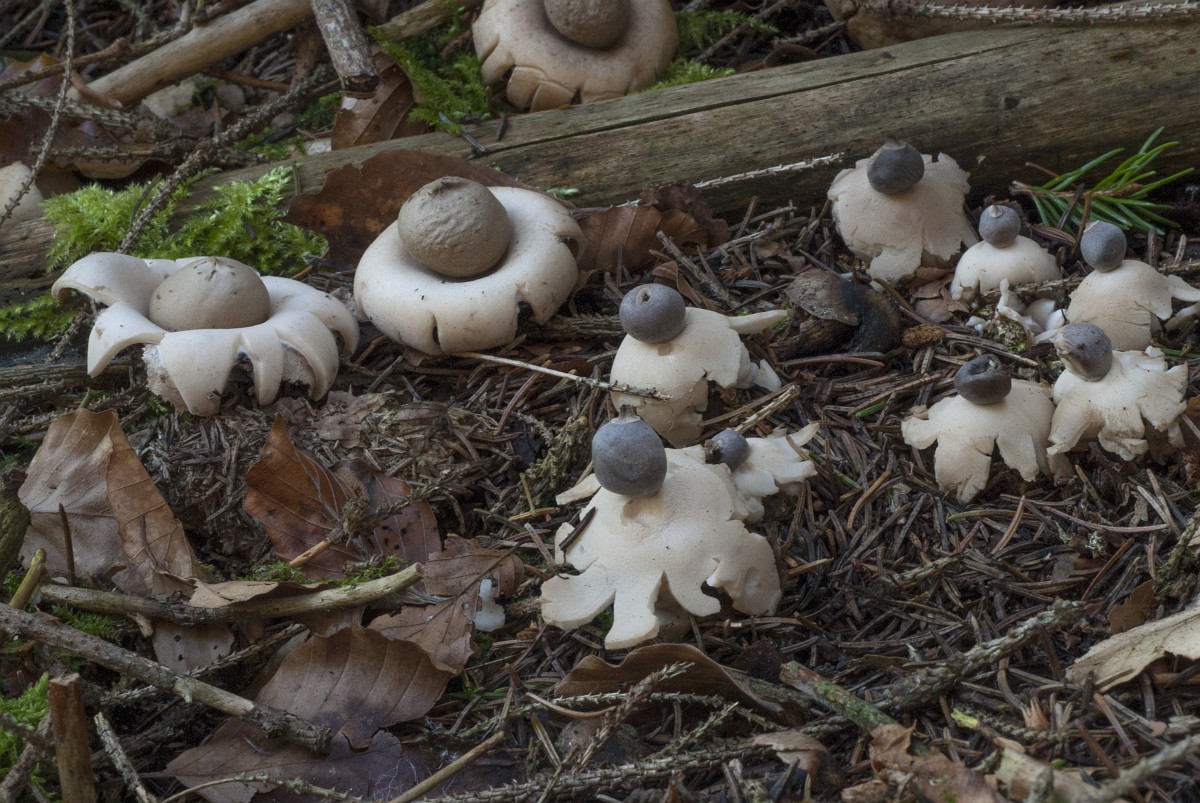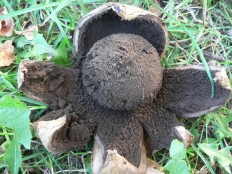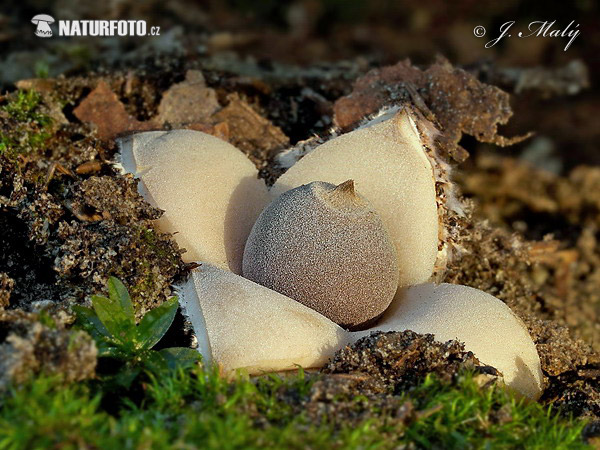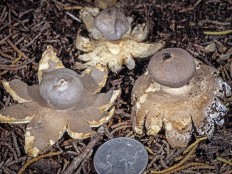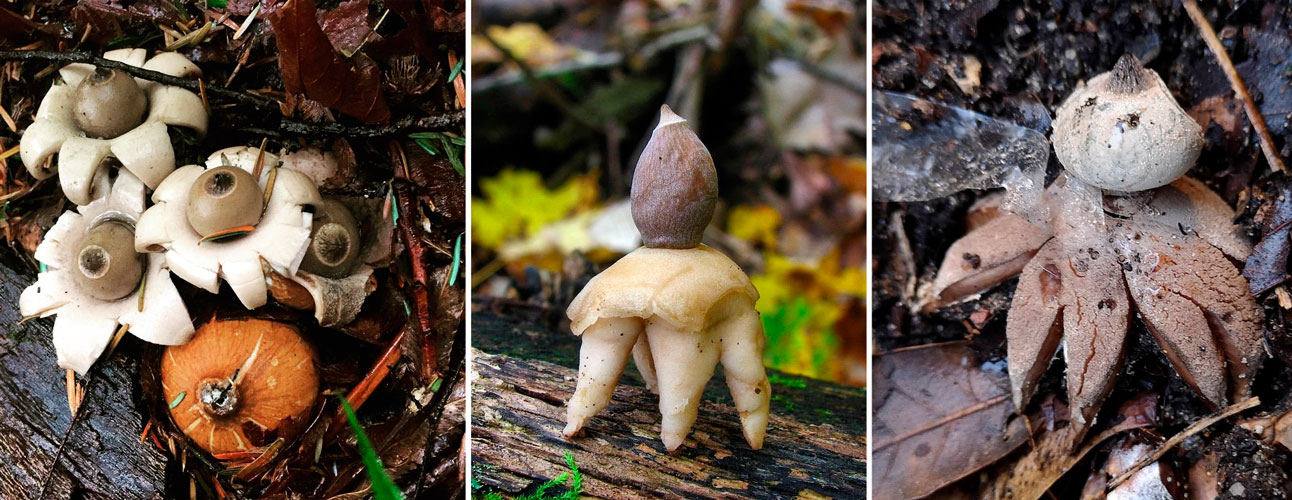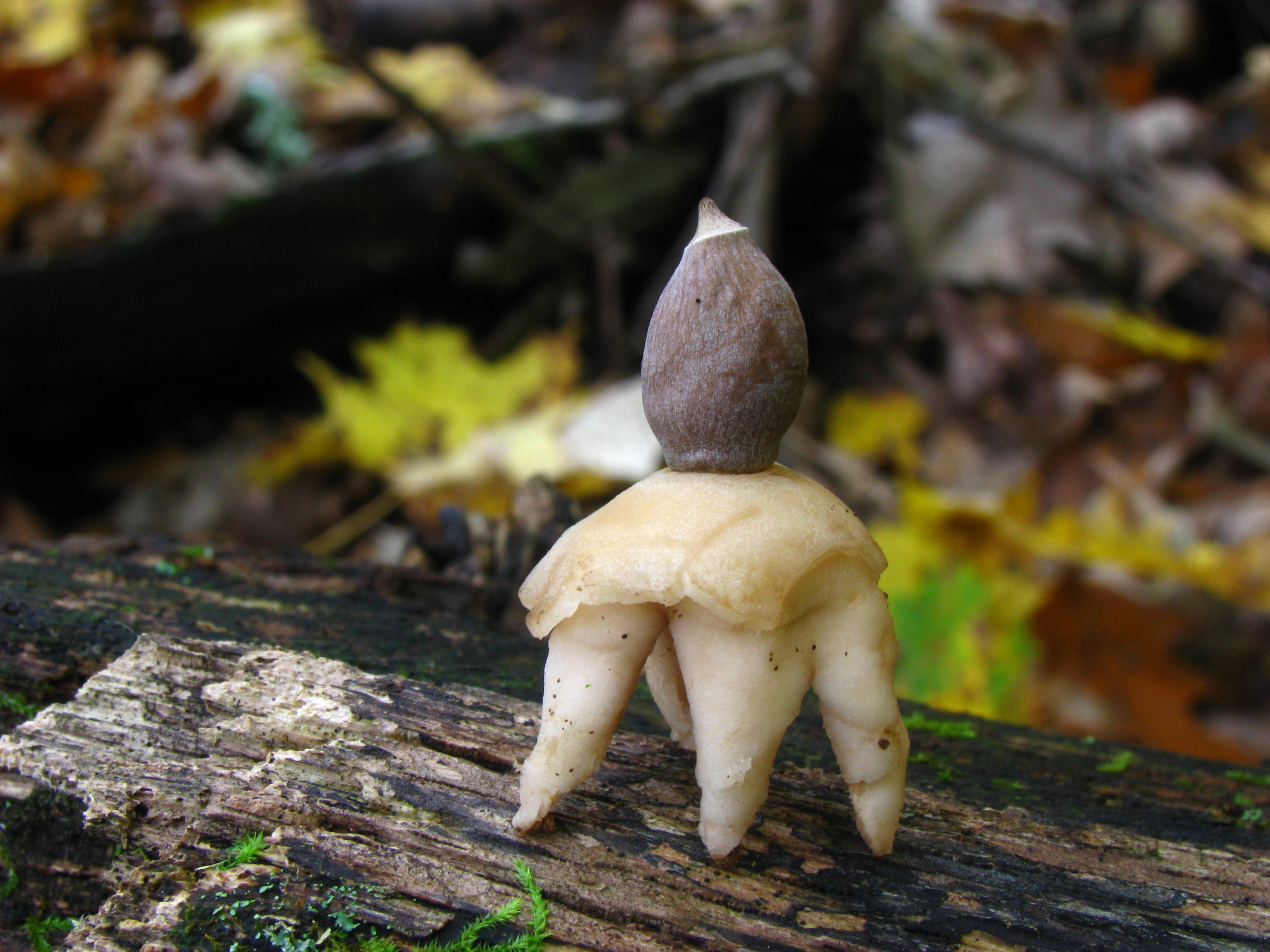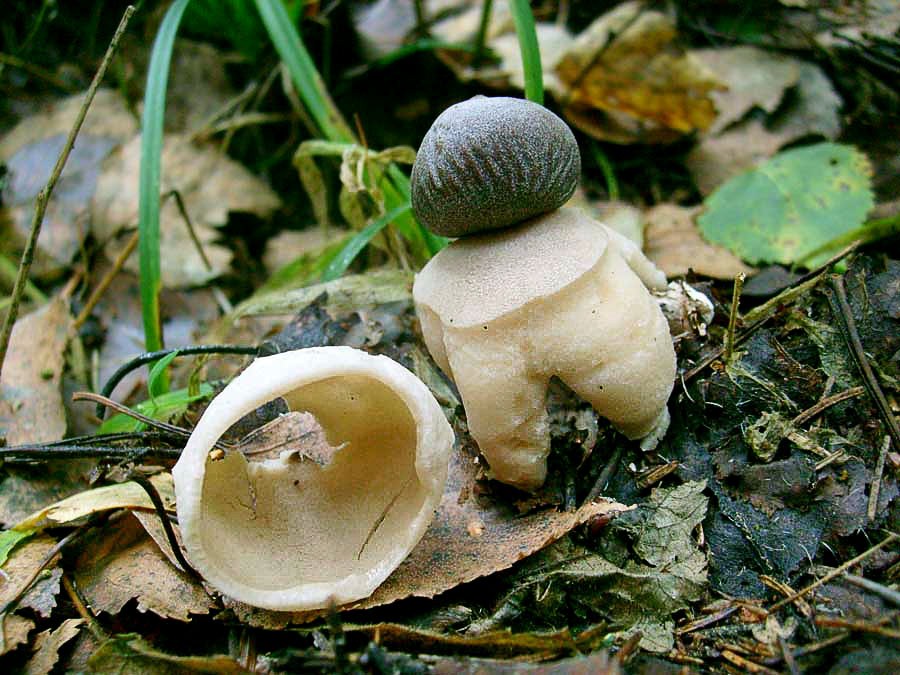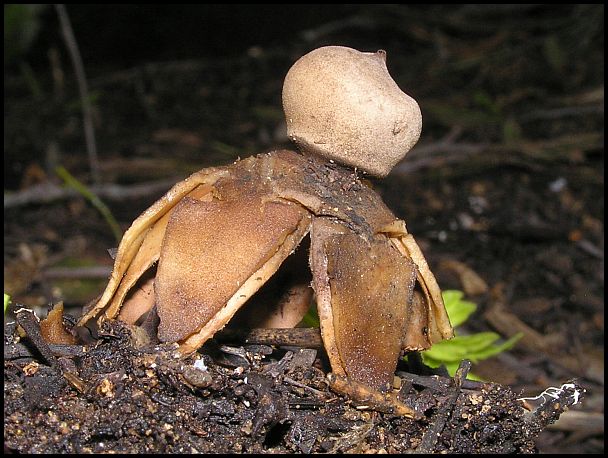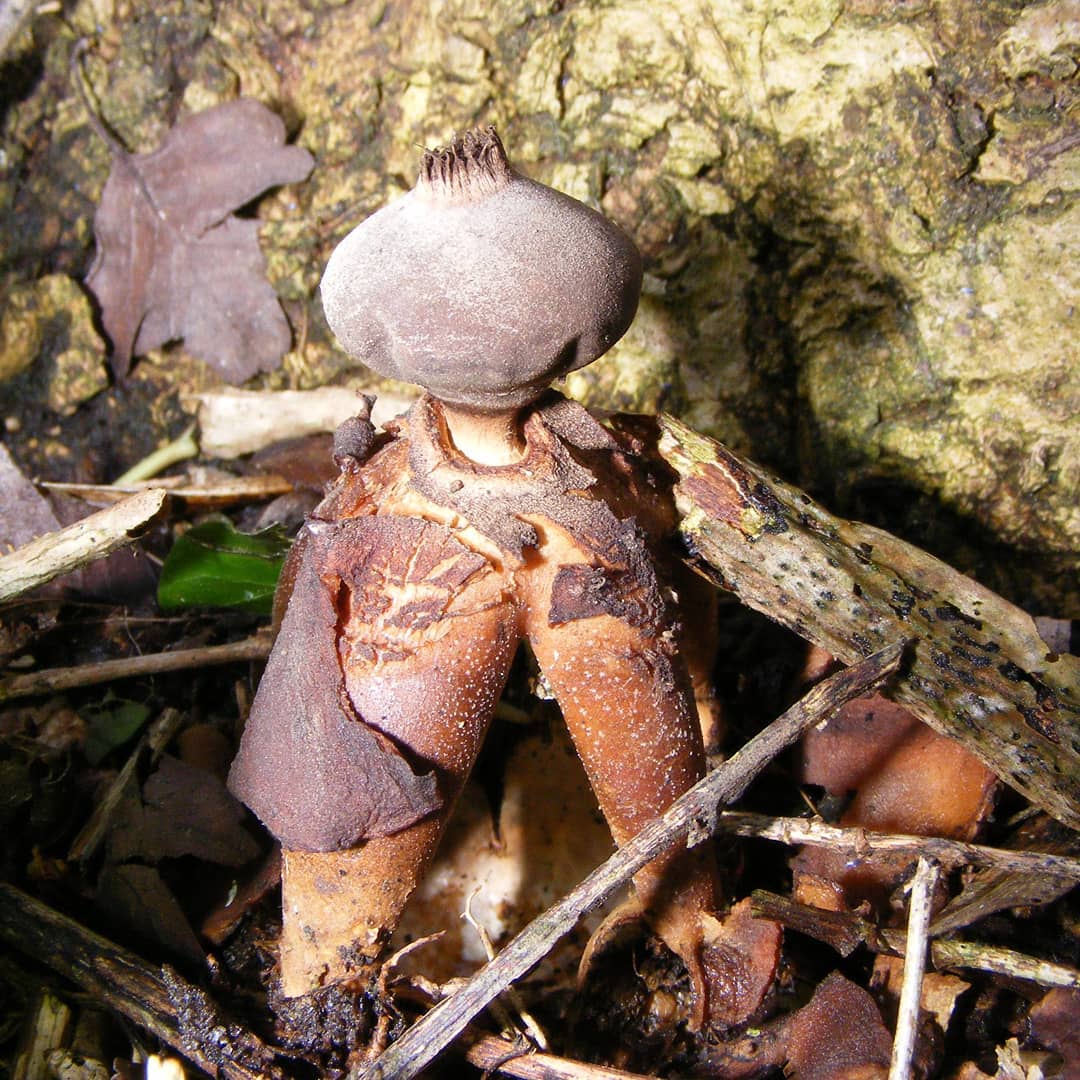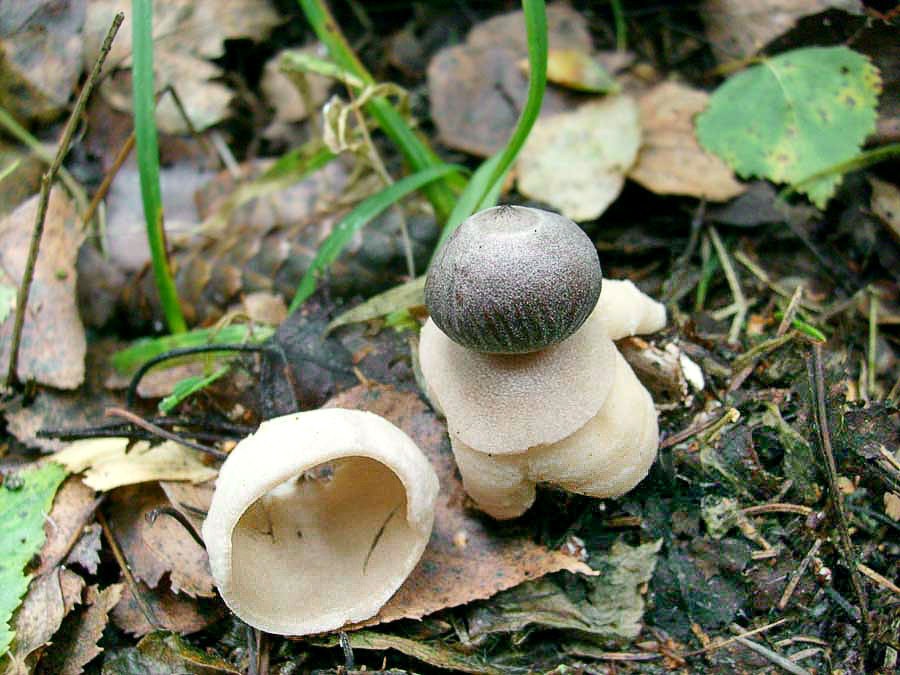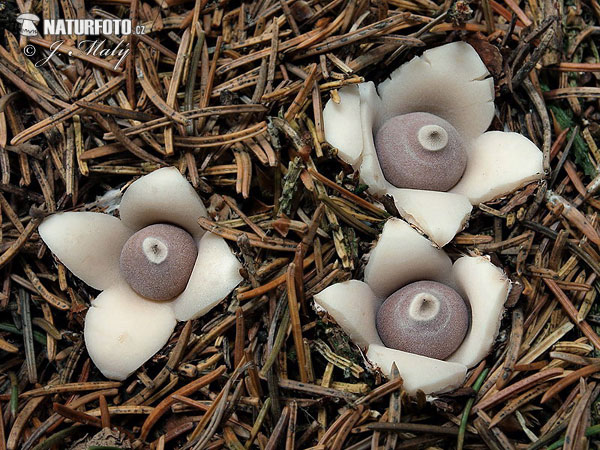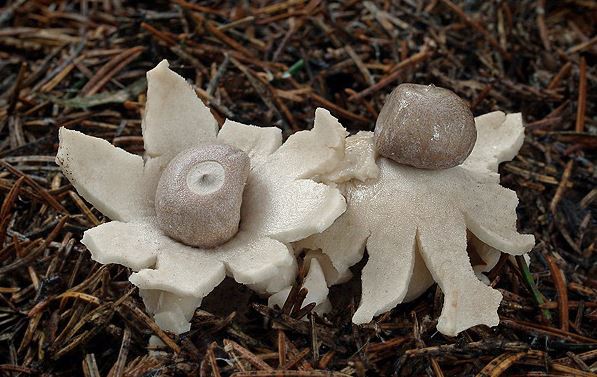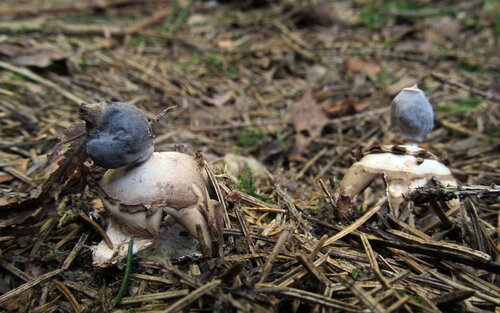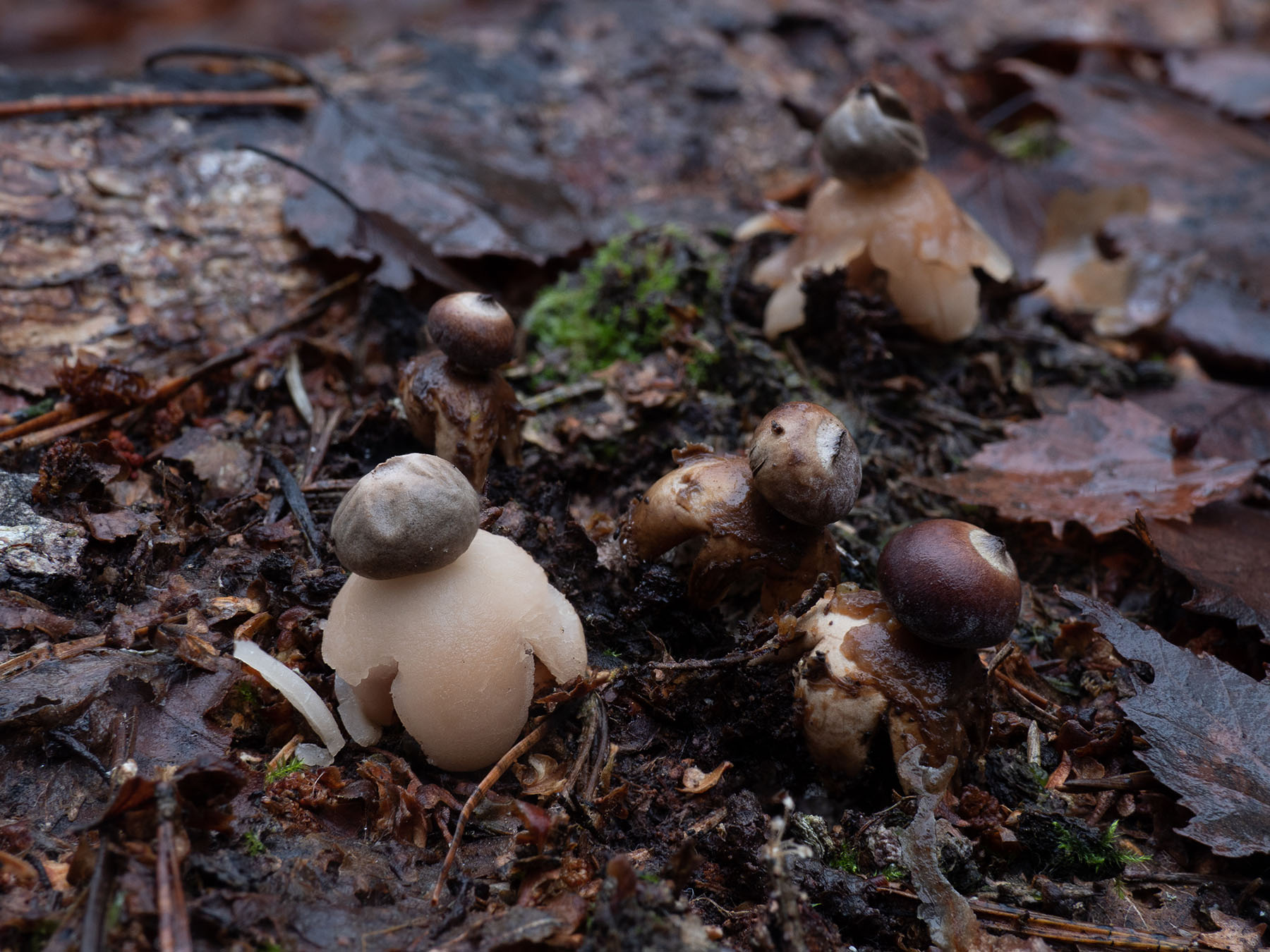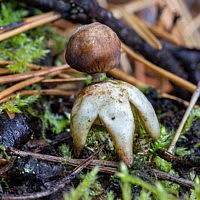Geastrum quadrifidum
- Other names for the mushroom:
- Starfire four-bladed
- Geastrum four-bladed
Synonyms:
- Star wheel four-part
- Geastrum four-bladed
- Earth star four-bladed
Description
Fruiting bodies are initially closed, spherical, about 2 cm in diameter, covered with a peridium, along the entire surface of which mycelial strands are located; mature - open, 3-5 cm in diameter. Peridium is four-layer, consists of exoperidium and endoperidium. Exoperidium in the form of a bowl, three-layer or two-layer, hard, breaks from top to bottom to the middle into 4 unequal, pointed parts (lobes), bending down, and fruiting bodies rise up on the lobes, as on "legs". The outer mycelial layer is whitish, felt, covered with soil particles, soon disappears. The middle fibrous layer is white or isabella, smooth. The inner fleshy layer is white, also torn into 4 parts, with sharp ends resting on the sharp ends of the blades of the outer layer, soon disappears. The base is convex. The middle rises up together with the inner part of the fruiting body - the gleba. The spherical or oval (ovoid) glebe is covered with endoperidium, 0.9-1.3 cm high and 0.7-1.2 cm wide. At the base with a flattened leg, above which the endoperidium is narrowed and a well-visible rounded protrusion (apophysis) is formed, at the apex it opens with an opening, which is equipped with a low peristome. The peristome is conical, fibrous, with a sharply limited courtyard, smoothly fibrous-ciliate, around which there is a clear ring. The stem is cylindrical or slightly flattened, 1.5-2 mm high and 3 mm thick, whitish. The column is cotton-wool, light brown-gray in section, 4-6 mm long. Its exoperidium ruptures more often by 4, less often by 4-8 unequal pointed lobes, bending downward, which is why the entire fruiting body rises up on the lobes, as on legs.
The leg (in the traditional sense) is missing.
Gleba is powdery when ripe, black-purple to brown. Spores are brownish, light or dark brown.
When pressed, the spores fly in all directions. Spores are olive brown.
HABITAT AND GROWTH TIME
The four-part starfish grows mostly on sandy soil in deciduous, mixed and coniferous - pine, spruce, pine-spruce and spruce-deciduous forests (among fallen needles), sometimes in abandoned anthills - from August to October, rarely. Recorded in Russia (European part, Caucasus and Eastern Siberia), Europe and North America. We found it southeast of St. Petersburg in a mixed forest (birch and spruce) under an old spruce on needles in early October (the mushrooms grew as a family).
TWINS
The four-part starfish is very peculiar in appearance and is strikingly different from mushrooms of other genera and families. It is similar to other starfish, for example, to the Vaulted starfish (Geastrum fornicatum), whose exoperidium splits into two layers: the outer one with 4-5 short, obtuse lobes and the inner, convex in the center, also with 4-5 lobes; on Zvezdovik crowned (Geastrum coronatum) with leathery, smooth exoperidium, splitting into 7-10 gray-brown pointed lobes; on Fringed Starfish (Geastrum fimbriatum) with exoperidium, which is torn by half or 2/3 - by 5-10 (less often up to 15) unequal blades; on Zvezdovik striped (G. striatum) with exoperidium, bursting into 6-9 lobes, and light gray gleb; on the small Starfish Shmiela (G. schmidelii) with exoperidium, forming 5-8 lobes, and a gleba with a beak-shaped grooved striped nose; on Zvezdovik triple (Geastrum triplex) with a fibrous hole at the top of a gray-brown block.
It is confined to the soils of deciduous and coniferous forests.
Description [| code]
Young fruit bodies are underground, almost spherical or flattened, with ingrown litter particles.When the exoperidium opens, it breaks star-like into 4-5 (6) rays, 1-4 (6) cm in height. The rays are not hygroscopic, erect, with "arches" lifting the endoperidium above the ground, wide, with edges curved inward. When straightening exoperidia up to 9 cm in diameter. Mycelial layer of exoperidium with ingrowing litter particles, whitish on the inside, durable. The fibrous layer (between the inner mycelial layer) leathery to filmy, from the side of the endoperidium, first covered with a pseudoparenchymal layer, then exposed and white, from the side of the mycelial layer whitish, shiny, then becomes off-brownish white. The inner (pseudoparenchymal) layer (covering the exoperidium from the side hidden in young fruiting bodies, then showing) is at first whitish, then darkens to brownish or gray-brownish, occasionally pinkish, cracks with age.
The endoperidium surrounding the glebe is raised above the "star" on the leg-shaped process, spherical or flattened, about 0.7-1 cm in diameter. The pinnate is clearly defined, disc-shaped or conical.
Spores are generally dark brown, spherical, with a finely warty surface, 5.5–6.3 µm in diameter (including ornament). Capillary hyphae are thick-walled, 3-6 microns thick, with thin ends, yellowish-brown.
It has no nutritional value, it is considered an inedible mushroom.
Similar species | code
- Geastrum leptospermum G. F. Atk. & Coker, 1903 - North American species, is even smaller, appears in winter and spring, grows on moss-covered stands of coniferous and deciduous trees.
- Geastrum minimum Schwein., 1822 - Small starfish - differs in a non-vaulted exoperidium with a large number of rays.
- Geastrum fornicatum (Huds.) Hook., 1821 - Vaulted starfish - is distinguished by the large size of the fruit bodies, more clearly limited by the peristome and smaller spores.
- Geastrum dissimile Bottomley, 1948 - African species, distinguished by a furrowed penistome.
- Geastrum welwitschii Mont., 1856 - is distinguished by ground young fruiting bodies, into the outer layer of which particles of litter do not grow, and also by a vaguely limited peristome.
Description
Young fruit bodies are underground, almost spherical or flattened, with ingrown litter particles. When the exoperidium opens, it breaks star-like into 4-5 (6) rays, 1-4 (6) cm in height. The rays are not hygroscopic, erect, with "arches" lifting the endoperidium above the ground, wide, with edges curved inward. When straightening exoperidia up to 9 cm in diameter. Mycelial layer of exoperidium with ingrowing litter particles, whitish on the inside, durable. The fibrous layer (between the inner mycelial layer) leathery to filmy, from the side of the endoperidium, first covered with a pseudoparenchymal layer, then exposed and white, from the side of the mycelial layer whitish, shiny, then becomes off-brownish white. The inner (pseudoparenchymal) layer (covering the exoperidium from the side hidden in young fruiting bodies, then showing) is at first whitish, then darkens to brownish or gray-brownish, occasionally pinkish, cracks with age.
The endoperidium surrounding the glebe is raised above the "star" on the leg-shaped process, spherical or flattened, about 0.7-1 cm in diameter. The pinnate is clearly defined, disc-shaped or conical.
Spores are generally dark brown, spherical, with a finely warty surface, 5.5–6.3 µm in diameter (including ornament). Capillary hyphae are thick-walled, 3-6 microns thick, with thin ends, yellowish-brown.
It has no nutritional value, it is considered an inedible mushroom.
Similar views edit code
- Geastrum leptospermum G. F. Atk. & Coker, 1903 - North American species, is even smaller, appears in winter and spring, grows on moss-covered stands of coniferous and deciduous trees.
- Geastrum minimum Schwein., 1822 - Small starfish - differs in a non-vaulted exoperidium with a large number of rays.
- Geastrum fornicatum (Huds.) Hook., 1821 - Vaulted starfish - is distinguished by the large size of the fruit bodies, more clearly limited by the peristome and smaller spores.
- Geastrum dissimile Bottomley, 1948 - African species, distinguished by a furrowed penistome.
- Geastrum welwitschii Mont., 1856 - is distinguished by ground young fruiting bodies, into the outer layer of which particles of litter do not grow, and also by a vaguely limited peristome.
Description
Young fruit bodies are underground, almost spherical or flattened, with ingrown litter particles. When the exoperidium opens, it breaks star-like into 4-5 (6) rays, 1-4 (6) cm in height. The rays are not hygroscopic, erect, with "arches" lifting the endoperidium above the ground, wide, with edges curved inward. When straightening exoperidia up to 9 cm in diameter. Mycelial layer of exoperidium with ingrowing litter particles, whitish on the inside, durable. The fibrous layer (between the inner mycelial layer) leathery to filmy, from the side of the endoperidium, first covered with a pseudoparenchymal layer, then exposed and white, from the side of the mycelial layer whitish, shiny, then becomes off-brownish white. The inner (pseudoparenchymal) layer (covering the exoperidium from the side hidden in young fruiting bodies, then showing) is at first whitish, then darkens to brownish or gray-brownish, occasionally pinkish, cracks with age.
The endoperidium surrounding the glebe is raised above the "star" on the leg-shaped process, spherical or flattened, about 0.7-1 cm in diameter. The pinnate is clearly defined, disc-shaped or conical.
Spores are generally dark brown, spherical, with a finely warty surface, 5.5–6.3 µm in diameter (including ornament). Capillary hyphae are thick-walled, 3-6 microns thick, with thin ends, yellowish-brown.
It has no nutritional value, it is considered an inedible mushroom.
Similar species
- Geastrum leptospermum G. F. Atk. & Coker, 1903 - North American species, is even smaller, appears in winter and spring, grows on moss-covered stands of coniferous and deciduous trees.
- Geastrum minimum Schwein., 1822 - Small starfish - differs in a non-vaulted exoperidium with a large number of rays.
- Geastrum fornicatum (Huds.) Hook., 1821 - Vaulted starfish - is distinguished by the large size of the fruit bodies, more clearly limited by the peristome and smaller spores.
- Geastrum dissimile Bottomley, 1948 - African species, distinguished by a furrowed penistome.
- Geastrum welwitschii Mont., 1856 - is distinguished by ground young fruiting bodies, into the outer layer of which particles of litter do not grow, and also by a vaguely limited peristome.
Red Book
Are you here:
Home - Red Data Book of Krasnoyarsk Territory - Earth star four-bladed
Earth star four-bladed
Mushrooms - Fungi
Four-lobed earth star - Geastrum quadrifidum DC ex Pers.
(1801)
Status: 4 (I). Undefined view.
Short description.
Undisclosed fruiting bodies are round, up to 2 cm, when opened, 2.5–5 cm in diameter, 1–5 cm in height. Exoperidium is two-layer: the soft outer mycelial layer remains in the substrate and forms a bowl, on the edges of which 4 (very rarely 3 or 5) non-hygroscopic, equal, rigid lobes of exoperidium rest with their tips.
Endoperidium is plum or ovate, non-grained, bluish-gray to blackish, recently opened specimens that have not been exposed to rain have small white shiny crystals; with a whitish flattened stalk 1 - 2 mm high and up to 3 mm wide, with a pronounced apophyseal at the base.
The pinnate is prominent, conical, fibrous, with a sharply delimited courtyard and disc, noticeably lighter than endoperidium. Gleb is dark brown with a purple tint. Columella is thick, loose, sometimes implicit. The spores are coarsely warty, 4.5 - 6 microns in diameter. Capillicum is light brown, up to 7.5 microns thick.
Spreading.
Krasnoyarsk Territory: the outskirts of Krasnoyarsk. In Russia: Republics of Altai, Khakassia, Leningrad, Moscow, Sverdlovsk, Tver regions. Outside Russia - Eurasia, Africa, Australia, North and South America.
Ecology and biology.
In coniferous and mixed forests. Litter saprotroph, grows on litter, often on old humified stumps, anthills.
Limiting factors. Reduction of the area of primary forests as the main habitat of the species.
Security measures. It is included in the Red Book of the Tver Region. It grows in the Olenyi Ruchyi Nature Park of the Sverdlovsk Region. It is necessary to control the state of populations and search for new ones.
Sources of information. Red Data Book of the Krasnoyarsk Territory. 1. Beglyanova, 1971; 2. Gorlenko et al., 1989; 3. Kovalenko, Morozova, 1999; 4. Kurochkin, Rebriev, 2005; 5. Maksimova, 2005; 6. Perova, Gorbunova, 2001; 7. Rebriev, 2007; 8. Rebriev, Gorbunova, 2007; 9. Shiryaev, 2008; 10. Mycological Herbarium, BIN RAS (LE); 11. Shvartsman, Filimonova, 1970; 12. Flora CSR. B. 1. Gasteromycetes, 1958; 13. Red Book of the Tver region, 2002; 14. Personal herbarium of Yu.A. Rebrieva. Compiled by Yu.A. Rebriev. Drawing: V.S. Stepanov, N.V. Stepanov.
|
28.11.2015 08:35:12
Back forward
-
Menu
- home
- Photo gallery
-
Animals
- Mammals
- Birds
- Fishes
- Amphibians
- Reptiles
- Insects
- Crustaceans
- Worms
- Molluscs
-
Plants
- Angiosperms
- Gymnosperms
- Ferns
- Mosses
- Seaweed
- Lichens
- Mushrooms
- Moscow
-
Moscow region
- Mammals
- Birds
- Invertebrates
- Pisces, presm., Terrestrial.
- Plants
- Mushrooms, mosses, lichens
-
Voronezh region
- Plants
- Animals
-
Republic of Crimea
- Plants
- Animals
-
Rostov region
- Plants
- Animals
-
Krasnodar Territory
- Plants
- Animals
-
Leningrad region
- Plants
- Animals
-
Pskov region
- Plants
- Animals
-
Sverdlovsk region
- Plants
- Animals
-
Saratov region
- Mushrooms
- Bryophytes
- Ferns
- Amur region
- Krasnoyarsk Territory
- Belgorod region
-
Chelyabinsk region
- Plants
- Animals
-
IUCN Red List
- Extinct mammals
- Rare birds of the world
- Cetaceans
- Carnivores
- Reserves of Russia
- Wild animals
- Birds of Russia
- Download the Red Book
- Basic documents
- Custom sog.
- .
Description
Young fruit bodies are underground, almost spherical or flattened, with ingrown litter particles. When the exoperidium opens, it breaks star-like into 4-5 (6) rays, 1-4 (6) cm in height. The rays are not hygroscopic, erect, with "arches" lifting the endoperidium above the ground, wide, with edges curved inward. When straightening exoperidia up to 9 cm in diameter. Mycelial layer of exoperidium with ingrowing litter particles, whitish on the inside, durable. The fibrous layer (between the inner mycelial layer) leathery to filmy, from the side of the endoperidium, first covered with a pseudoparenchymal layer, then exposed and white, from the side of the mycelial layer whitish, shiny, then becomes off-brownish white. The inner (pseudoparenchymal) layer (covering the exoperidium from the side hidden in young fruiting bodies, then showing) is at first whitish, then darkens to brownish or gray-brownish, occasionally pinkish, cracks with age.
The endoperidium surrounding the glebe is raised above the "star" on the leg-shaped process, spherical or flattened, about 0.7-1 cm in diameter. The pinnate is clearly defined, disc-shaped or conical.
Spores are generally dark brown, spherical, with a finely warty surface, 5.5–6.3 µm in diameter (including ornament). Capillary hyphae are thick-walled, 3-6 microns thick, with thin ends, yellowish-brown.
It has no nutritional value, it is considered an inedible mushroom.
Similar views edit code
- Geastrum leptospermum G. F. Atk. & Coker, 1903 - North American species, is even smaller, appears in winter and spring, grows on moss-covered stands of coniferous and deciduous trees.
- Geastrum minimum Schwein., 1822 - Small starfish - differs in a non-vaulted exoperidium with a large number of rays.
- Geastrum fornicatum (Huds.) Hook., 1821 - Vaulted starfish - is distinguished by the large size of the fruit bodies, more clearly limited by the peristome and smaller spores.
- Geastrum dissimile Bottomley, 1948 - African species, distinguished by a furrowed penistome.
- Geastrum welwitschii Mont., 1856 - is distinguished by ground young fruiting bodies, into the outer layer of which particles of litter do not grow, and also by a vaguely limited peristome.
Red Book
Are you here:
Home - Red Data Book of the Amur Region - Fringed Earth Star
Fringed earth star
Family Starfish - Geastraceae
Fringed earth star - Geastrum fimbriatum Fr.
Category and status .. 3 b. A rare species with a significant range, within which they occur sporadically and with a small number of populations.
A brief description of. In the Amur region - Arkharinsky district (st. Uril), the vicinity of Blagoveshchensk (tract "Mukhinka") (1, 2). In Russia - the European part, the North Caucasus, Siberia, the Far East (Primorsky Territory). A cosmopolitan look, found on all continents.
A brief description of. The fruiting body is initially spherical, develops in the ground, 4-6 cm in diameter when unfolded. Later, the three-layer shell is torn apart.
The outer shell (exoperidium) opens up to half or up to 2/3 and disintegrates in the form of a star into 5-10 (less often up to 15) unequal lobes. Exoperidium 0.2-0.3 cm thick, papery outside, fleshy inside, later brittle, whitish or yellowish-brown, dry brown or buffy.
The blades are open, sharp, curled down when dry. The unbroken part of the exoperidium is cupped, covered with soil particles from the outside.
The inner part of the fruiting body (gleb) with a diameter of 1.0-2.5 cm, resembles the fruiting body of a raincoat: round, without a leg, enclosed in a paper-thin shell (endoperidium), in which spores ripen; later they exit through the fibrous-ciliated opening at the top.
Spore powder chocolate brown. Spores are rounded, warty, 3.5 µm in diameter. Endoperidium smooth or rough, pale yellow or brown. The pulp is tough, without any special smell or taste (2, 3).
Features of ecology and phytocenology. Fruiting bodies appear in August-September in groups or "witch's rings" mainly on the litter on alkaline soil under coniferous and deciduous trees in different types of forest.
Limiting factors. Not studied. Possibly destruction of the gum litter as a result of fires and recreation.
Security measures taken. Fringed earth star is included in the Red Book of the Russian Federation (4), protected in the Blagoveshchensky reserve.
Necessary security measures. Clarification of the range, identification of new locations of the species and their monitoring, preservation of natural habitats.
Sources of information. 1 Nazarova, Vasilieva, 1974; 2. Data of the originator; 3. Sosin, 1973; 4. Red Book of the RSFSR, 1988. Compiled. ON. Kochunov.
|
20.10.2015 20:23:49
Back forward
-
Menu
- home
- Photo gallery
-
Animals
- Mammals
- Birds
- Fishes
- Amphibians
- Reptiles
- Insects
- Crustaceans
- Worms
- Molluscs
-
Plants
- Angiosperms
- Gymnosperms
- Ferns
- Mosses
- Seaweed
- Lichens
- Mushrooms
- Moscow
-
Moscow region
- Mammals
- Birds
- Invertebrates
- Pisces, presm., Terrestrial.
- Plants
- Mushrooms, mosses, lichens
-
Voronezh region
- Plants
- Animals
-
Republic of Crimea
- Plants
- Animals
-
Rostov region
- Plants
- Animals
-
Krasnodar Territory
- Plants
- Animals
-
Leningrad region
- Plants
- Animals
-
Pskov region
- Plants
- Animals
-
Sverdlovsk region
- Plants
- Animals
-
Saratov region
- Mushrooms
- Bryophytes
- Ferns
- Amur region
- Krasnoyarsk Territory
- Belgorod region
-
Chelyabinsk region
- Plants
- Animals
-
IUCN Red List
- Extinct mammals
- Rare birds of the world
- Cetaceans
- Carnivores
- Reserves of Russia
- Wild animals
- Birds of Russia
- Download the Red Book
- Basic documents
- Custom sog.
- .

